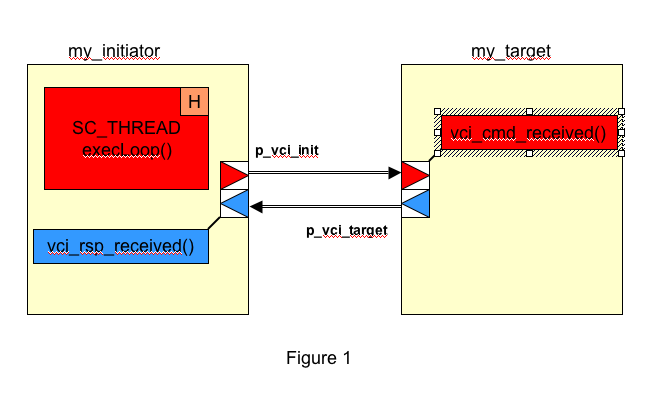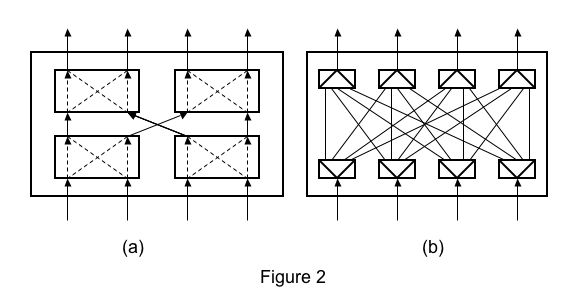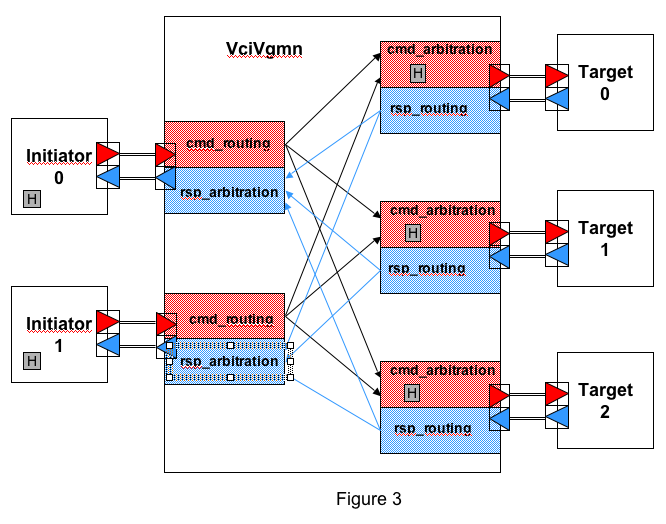| Version 76 (modified by , 17 years ago) (diff) |
|---|
Writing TLM2.0-compliant timed SystemC simulation models for SoCLib
Authors : Alain Greiner, François Pêcheux, Aline Vieira de Mello
A) Introduction
This document is still under development.
It describes the modeling rules for writing TLM-T SystemC simulation models for SoCLib that are compliant with the new TLM2.0 OSCI standard. These rules enforce the PDES (Parallel Discrete Event Simulation) principles. In the TLM-T approach, we don't use the SystemC global time, as each PDES process involved in the simulation has its own local time. PDES processes (implemented as SC_THREADS) synchronize through messages piggybacked with time information. Models complying to these rules can be used with the "standard" OSCI simulation engine (SystemC 2.x) and the TLM2.0 library, but can also be used also with others simulation engines, especially distributed, parallelized simulation engines.
The examples presented below use the VCI/OCP communication protocol selected by the SoCLib project, but the TLM-T approach described here is very flexible, and is not limited to the VCI/OCP communication protocol.
The interested user should also look at the general SoCLib rules.
B) Single VCI initiator and single VCI target
Figure 1 presents a minimal system containing one single VCI initiator, my_initiator , and one single VCI target, my_target . The initiator behavior is modeled by the SC_THREAD execLoop(), that contains an infinite loop. The call-back function vci_rsp_received() is executed when a VCI response packet is received by the initiator module.

Unlike the initiator, the target module has a purely reactive behaviour and is therefore modeled as a simple call-back function. In other words, there is no need to use a SC_THREAD for this simple target component: the target behaviour is entirely described by the call-back function vci_cmd_received(), that is executed when a VCI command packet is received by the target module.
The VCI communication channel is a point-to-point bi-directional channel, encapsulating two separated uni-directional channels: one to transmit the VCI command packet, one to transmit the VCI response packet.
C) VCI Transaction in TLM-T
The TLM2.0 standard allows the user to redefine both the payload and the phases of the transactions. Two classes have been defined in soclib_vci_types : a tlmt_vci_transaction and a tlmt_phase".
The payload of a tlmt_vci_transaction contains three groups of information:
- TLM2.0 generic fields
- TLM-T specific fields
- VCI specific fields
class tlmt_vci_transaction { ... private: // TLM2.0 related fields and common structure sc_dt::uint64 m_address; // address unsigned char* m_data; // data buffer unsigned int m_length; // number of bytes tlm_response_status m_response_status; // rerror unsigned char* m_byte_enable; // be buffer unsigned int m_streaming_width; // // TLM-T related fields bool* m_activity_ptr; sc_core::sc_time* m_local_time_ptr; // VCI related fields vci_command m_command; // cmd unsigned int m_src_id; // srcid unsigned int m_trd_id; // trdid unsigned int m_pkt_id; // pktid
The TLM2.0 compliant accessors allow to set the TLM2.0 related fields, such as the transaction address, the data & byte enable arrays pointers and its associated size in bytes.
Dedicated VCI accessors are used to define the VCI transaction type, that can either be set_read() (for read command), set_write() (for write command),set_locked_read() (for atomic locked read), and set_store_cond() (for atomic store conditional). The set_src_id(), set_trd_id() and set_pkt_id() functions respectively set the VCI source, thread and packet identifiers.
NB : The byte array approach defined by TLM2.0 can degrade the simulation speed, as the existing SoCLib models use uint32_t arrays to model both the embedded memory and the caches... Experiments are currently in progress to evaluate the performance degradation incurred by this byte formatting. It is therefore possible that the types of the m_data and m_byte_enable of the tlmt_vci_transaction will be changed to uint32* .
D) VCI initiator Modeling
D.1) Member variables & methods
In the proposed example, the initiator module is modeled by the my_initiator class. This class inherits from the standard SystemC sc_core::sc_module class, that acts as the root class for all TLM-T modules.
The initiator local time is contained in a member variable named m_localTime, of type sc_core::sc_time. The local time can be accessed with the following accessors: addLocalTime(), setLocalTime() and getLocalTime().
sc_core::sc_time m_localTime; // the initiator local time ... void addLocalTime(sc_core::sc_time t); // add an increment to the local time void setLocalTime(sc_core::sc_time& t); // set the local time sc_core::sc_time getLocalTime(void); // get the local time
The boolean member variable m_activity indicates if the initiator is currently active. It is used by the arbitration threads contained in the vci_vgmn interconnect, as described in section F. The corresponding access functions are setActivity() and getActivity().
bool m_activity; ... void setActivity(bool t); // set the activity status (true if the component is active) bool getActivity(void); // get the activity state
The execLoop() method, describing the initiator behaviour must be declared as a member function.
The my_initiator class must define a call-back function to handle the VCI response packets.
Finally, the it must contain a member variable p_vci_init, of type tlmt_simple_initiator_socket. This member variable represents the VCI initiator port.
D.2) Sending a VCI command packet
To send a VCI command packet, the execLoop() method must use the nb_transport_fw() method, defined by TLM2.0, that is a member function of the p_vci_init port. The prototype of this method is the following:
tlm::tlm_sync_enum nb_transport_fw
( soclib_vci_types::tlm_payload_type &payload, // VCI payload pointer
soclib_vci_types::tlm_phase_type &phase, // transaction phase (TLMT_CMD)
sc_core::sc_time &time); // local time
The first argument is a pointer to the payload, the second represents the phase, and the third argument contains the initiator local time.
The nb_transport_fw() function is non-blocking. To implement a blocking transaction (such as a cache line read, where the processor is stalled during the VCI transaction), the model designer must use the SystemC sc_core::wait(x) primitive (x being of type sc_core::sc_event): the execLoop() thread is then suspended, and will be reactivated when the response packet is actually received.
D.3) Receiving a VCI response packet
To receive a VCI response packet, a call-back function must be defined as a member function of the class my_initiator. This call-back function (named vci_rsp_received() in the example), must be linked to the p_vci_init port, and is executed each time a VCI response packet is received on the p_vci_init port. The function name is not constrained, but the arguments must respect the following prototype:
tlm::tlm_sync_enum vci_rsp_received
( soclib_vci_types::tlm_payload_type &payload, // payload
soclib_vci_types::tlm_phase_type &phase, // transaction phase (TLMT_RSP)
sc_core::sc_time &time); // response time
The return value (type tlm::tlm_sync_enum) is not used in this tlmt implementation, and must be sytematically set to tlm::TLM_COMPLETED.
In the general case, the actions executed by the call-back function depend on the transaction type defined in the payload (m_command, m_pktid and m_trdid fields). For sake of simplicity, the call-back function proposed in the example below does not make any distinction between transaction types.
D.4) Initiator Constructor
The constructor of the class my_initiator must initialize all the member variables, including the p_vci_init port. The vci_rsp_received() call-back function being executed in the context of the thread sending the response packet, a link between the p_vci_init port and this call-back function must be established.
The constructor for the p_vci_init port must be called with the following arguments:
p_vci_init.register_nb_transport_bw(this, &my_initiator::vci_rsp_received);
D.5) Lookahead parameter
The SystemC simulation engine behaves as a cooperative, non-preemptive multi-tasks system. Any thread in the system must stop execution after at some point, in order to allow the other threads to execute. With the proposed approach, a TLM-T initiator will never stop if it does not execute blocking communication (such as a processor that has all code and data in the L1 caches).
To solve this issue, it is necessary to define -for each initiator module- a lookahead parameter. This parameter defines the maximum number of cycles that can be executed by the thread before it is descheduled. The lookahead parameter allows the system designer to bound the de-synchronization time interval between threads.
A small value for this parameter results in a better timing accuracy for the simulation, but implies a larger number of context switches, and a slower simulation speed.
D.6) VCI initiator example
////////////////////////// my_initiator.h //////////////////////////////// ////////////////////////// my_initiator.cpp ////////////////////////////////
E) VCI target modeling
In the proposed example, the my_target component handles all VCI commands in the same way, and there is no error management.
E.1) Member variables & methods
The class my_target inherits from the class sc_core::sc_module. The class my_target contains a member variable p_vci_target of type tlmt_simple_target_socket, representing the VCI target port. It contains a call-back function to handle the received VCI command packets, as described below.
E.2) Receiving a VCI command packet
To receive a VCI command packet, a call-back function must be defined as a member function of the class my_target. This call-back function (named vci_cmd_received() in the example), is executed each time a VCI command packet is received on the p_vci_target port. The function name is not constrained, but the arguments must respect the following prototype:
tlm::tlm_sync_enum vci_cmd_received
( soclib_vci_types::tlm_payload_type &payload, // VCI payload pointer
soclib_vci_types::tlm_phase_type &phase, // transaction phase
sc_core::sc_time &time); // time
E.3) Sending a VCI response packet
To send a VCI response packet the call-back function vci_cmd_received() use the nb_transport_bw() method, that is a member function of the class tlmt_simple_target_socket, and has the same arguments as the nb_transport_fw() function. Respecting the general TLM2.0 policy, the payload argument refers to the same tlmt_vci_transaction object for both the nb_transport_fw() and nb_transport_bw() functions, and the associated call-back functions. The set_response_status field must be documented for all transaction types, but only two values are used in this TLM-T implementation:
- TLMT_OK_RESPONSE
- TLMT_ERROR_RESPONSE
For a reactive target, the response packet time is computed as the command packet time plus the target intrinsic latency.
payload.set_response_status(soclib::tlmt::TLMT_OK_RESPONSE); phase = soclib::tlmt::TLMT_RSP; time = time + (nwords * UNIT_TIME); p_vci_target->nb_transport_bw(payload, phase, time);
E.4) Target Constructor
The constructor of the class my_target must initialize all the member variables, including the p_vci_target port. The vci_cmd_received() call-back function being executed in the context of the thread sending the command packet, a link between the p_vci_target port and the call-back function must be established. The my_target constructor must be called with the following arguments:
p_vci_target.register_nb_transport_fw(this, &my_target::vci_cmd_received);
E.5) VCI target example
////////////////////////// my_target.h //////////////////////////////// ////////////////////////// my_target.cpp ////////////////////////////////
F) VCI Interconnect modelling
The VCI interconnect used for the TLM-T simulation is a generic interconnection network, named VciVgmn. The two main parameters are the number of initiators, and the number of targets. In TLM-T simulation, we don't want to reproduce the cycle-accurate behavior of a particular interconnect. We only want to simulate the contention in the network, when several VCI intitiators try to reach the same VCI target. Therefore, the network is actually modeled as a complete cross-bar : In a physical network such as the multi-stage network described in Figure 2.a, conflicts can appear at any intermediate switch. In the VciVgmn network described in Figure 2.b, conflicts can only happen at the output ports. It is possible to specify a specific latency for each input/output couple. As in most physical interconnects, the general arbitration policy is round-robin.

F.1) Generic network modeling
There is actually two fully independent networks for VCI command packets and VCI response packets. There is a routing function for each input port, and an arbitration function for each output port, but the two networks are not symmetrical :
- For the command network, the arbitration policy is distributed: there is one arbitration thread for each output port (i.e. one arbitration thread for each VCI target). Each arbitration thread is modeled by a SC_THREAD, and contains a local clock.
- For the response network, there are no conflicts, and there is no need for arbitration. Therefore, there is no thread (and no local time) and the response network is implemented by simple function calls.
This is illustrated in Figure 3 for a network with 2 initiators and three targets :

F.2) Arbitration Policy
As described above, there is one cmd_arbitration thread associated to each VCI target. This thread is in charge of selecting one timed request between all possible requesters, and to forward it to the target. According to the PDES principles, the arbitration thread must select the request with the smallest timestamp. The arbitration process must take into account the actual state of the VCI initiators: For example a DMA coprocessor that has not yet been activated will not send request and should not participate in the arbitration process. As a general rule, each VCI initiator must define an active boolean flag, defining if it should participate to the arbitration. This active flag is always set to true for general purpose processors. Any arbitration thread receiving a timed request is resumed. It must obtain an up to date timing & activity information for all its input channels before making any decision. To do that, the LocalTime and ActivityStatus of all VCI initiators are considered as global variables, that can be accessed (read only) by all arbitration threads. The arbitration policy is the following : The arbitration thread scans all its input channels, and selects the smallest time between the active initiators. If there is a request, this request is forwarded to the target, and the arbitration thread local time is updated. If there is no request from this initiator, the thread is descheduled and will be resumed when it receives a new request.
For efficiency reasons, in this implementation, each arbitration thread constructs - during elaboration of the simulation - two local array of pointers (indexed by the input channel index) to access the LocalTime and ActivityStatus variables of the corresponding VCI initiators. To get this information, each arbitration thread uses the nb_transport_bw() function on all its VCI target ports, with a a dedicated value for the phase called soclib::tlmt::TLMT_INFO. The payload argument refers to the same tlmt_vci_transaction object as the two other phase values (soclib::tlmt::TLMT_CMD and soclib::tlmt::TLMT_RSP).
for (size_t i=0;i<m_nbinit;i++) {
phase = soclib::tlmt::TLMT_INFO;
m_RspArbCmdRout[i]->p_vci->nb_transport_bw(payload, phase, rspTime);
m_array[i].ActivityStatus = payload.get_activity_ptr();
m_array[i].LocalTime = payload.get_local_time_ptr();
}
As the net-list of the simulated platform mus be explicitely defined before constructing those LocalTime and ActivityStatus arrays, the vgmn hardware component provides an utility function fill_time_activity_arrays() that must be called in the SystemC top-cell, before starting the simulation.
Attachments (7)
- tlmt_figure_2.png (17.3 KB) - added by 18 years ago.
- tlmt_figure_4.png (21.5 KB) - added by 18 years ago.
- tlmt_figure_3.png (59.0 KB) - added by 18 years ago.
- tlmt_figure_5.png (7.2 KB) - added by 18 years ago.
- tlmt_figure_1.png (18.7 KB) - added by 17 years ago.
- tlmt_vgmn.png (33.3 KB) - added by 17 years ago.
- tlmt_initiator_target.png (10.2 KB) - added by 17 years ago.
Download all attachments as: .zip

